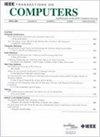Lock-Free Triangle Counting on GPU
IF 3.6
2区 计算机科学
Q2 COMPUTER SCIENCE, HARDWARE & ARCHITECTURE
引用次数: 0
Abstract
Finding the triangles of large scale graphs is a fundamental graph mining task in many applications, such as motif detection, microscopic evolution, and link prediction. The recent works on triangle counting can be classified into merge-based or binary search-based paradigms. The merge-based triangle counting paradigm locates the triangles using the set intersection operation, which suffers from the random memory access problem. The binary search-based triangle counting paradigm sets the neighbors of the source vertex of an edge as the lookup array and searches the neighbors of the destination vertex. There are lots of expensive lock operations needed in the binary search-based paradigm, which leads to low thread efficiency. In this paper, we aim to improve the triangle counting efficiency on GPU by designing a lock-free policy named Skiff to implement a hash-based triangle counting algorithm. In Skiff, we first design a hash trie data layout to meet the coalesced memory access model and then propose a lock-free policy to reduce the conflicts of the hash trie. In addition, we use a level array to manage the index of the hash trie to make sure the nodes of the hash trie can be quickly located. Furthermore, we implement a CTA thread organization model to reduce the load imbalance of the real-world graphs. We conducted extensive experiments on NVIDIA GPUs to show the performance of Skiff. The results show that Skiff can achieve a good system performance improvement than the state-of-the-art (SOTA) works.GPU上的无锁三角形计数
在许多应用中,寻找大尺度图的三角形是一个基本的图挖掘任务,如基序检测、微观进化和链接预测。最近关于三角形计数的研究可以分为基于合并的和基于二进制搜索的两种范式。基于合并的三角形计数范式使用集合交集操作来定位三角形,但存在随机内存访问问题。基于二进制搜索的三角形计数范例将边的源顶点的邻居设置为查找数组,并搜索目标顶点的邻居。在基于二进制搜索的范式中,需要进行大量昂贵的锁操作,这导致线程效率较低。为了提高GPU上三角形计数的效率,我们设计了一个无锁策略Skiff来实现基于哈希的三角形计数算法。在Skiff中,我们首先设计了一个哈希树数据布局来满足合并内存访问模型,然后提出了一个无锁策略来减少哈希树的冲突。此外,我们使用一个级别数组来管理哈希树的索引,以确保哈希树的节点可以快速定位。此外,我们实现了一个CTA线程组织模型,以减少实际图的负载不平衡。我们在NVIDIA gpu上进行了大量的实验来展示Skiff的性能。结果表明,与现有的SOTA系统相比,Skiff系统的性能得到了较好的提高。
本文章由计算机程序翻译,如有差异,请以英文原文为准。
求助全文
约1分钟内获得全文
求助全文
来源期刊

IEEE Transactions on Computers
工程技术-工程:电子与电气
CiteScore
6.60
自引率
5.40%
发文量
199
审稿时长
6.0 months
期刊介绍:
The IEEE Transactions on Computers is a monthly publication with a wide distribution to researchers, developers, technical managers, and educators in the computer field. It publishes papers on research in areas of current interest to the readers. These areas include, but are not limited to, the following: a) computer organizations and architectures; b) operating systems, software systems, and communication protocols; c) real-time systems and embedded systems; d) digital devices, computer components, and interconnection networks; e) specification, design, prototyping, and testing methods and tools; f) performance, fault tolerance, reliability, security, and testability; g) case studies and experimental and theoretical evaluations; and h) new and important applications and trends.
 求助内容:
求助内容: 应助结果提醒方式:
应助结果提醒方式:


